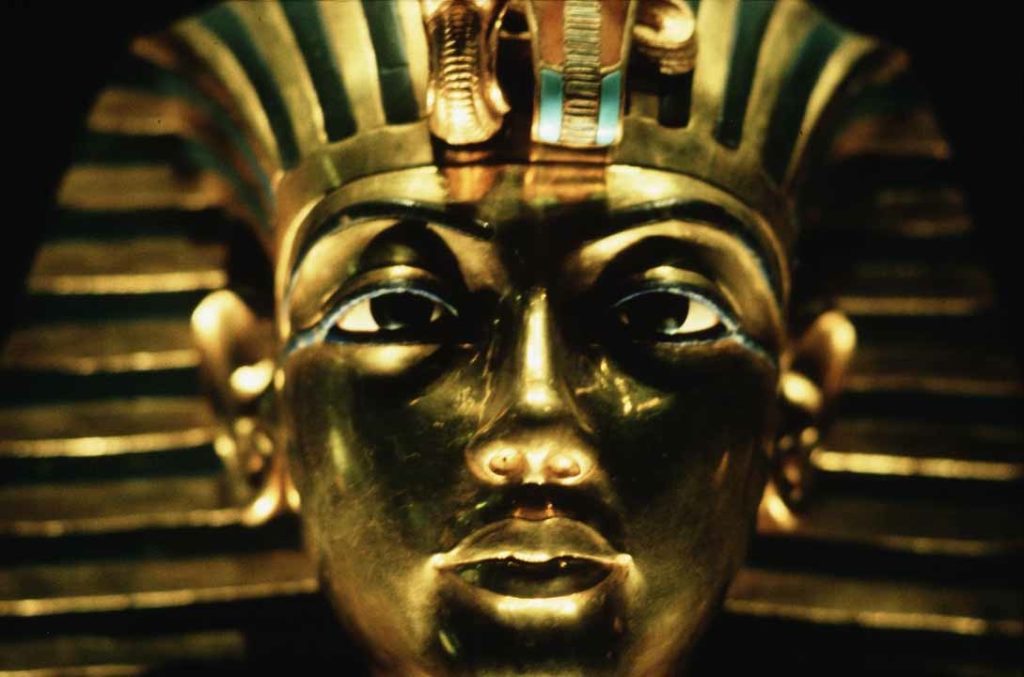
“Golden Mask of King Tut (Cairo)” by Lucas is licensed under CC BY 2.0
I gave bread to the hungry, beer to the thirsty, clothes to the naked, and a boat to him who was boatless.”— Liturgy from the “Book of the Dead”
Lay of the Land
Egypt is a land of very little rainfall, averaging only 10 millimeters annually, not so different from the Moché environment of Peru. The Nile River, so critical to Egyptian culture, flows south to north through this vast desert. The Nile flows from mountains in the south to the Mediterranean in the north. Perhaps a little counter-intuitively, the northern delta is called Lower Egypt because of its downstream position. The southern portion of Egypt is called Upper Egypt because of its upstream position. Prevailing winds blew from the north to the south and so Egyptians used sails for going south and the natural current for heading north. In hieroglyphics, going south is indicated by ships with sails and going north by those without. To the south lay Nubia, below the first cataract of the Nile, where the river flows through granite and is marked by boulders and rapids.
The Nile has deposited fertile silty soils along its banks, providing the desert a richness along the valley floor. Egyptians called the Nile floodplain “Kemet” (meaning black land) for its fertile soil and the Nile itself Iteru. In ancient Egypt, the Nile flooded annually about 7 or 8 meters, bringing water and fertile silt from the African interior while at the same time removing salts. When the waters receded, a narrow strip of land along the Nile became agriculturally productive. Because the surrounding land was arid desert, this narrow strip along the Nile became densely populated. Flooding also facilitated the movement of building stones and statuary directly from quarries along the Nile cliffs onto barges. In the 1960s, the construction of the Aswan Dam stopped the annual flooding that for so long directed the lives of the Egyptians.
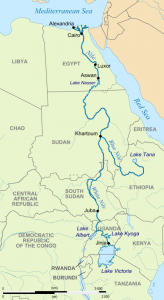
The Blue and White Nile feed into the Nile. “White and Blue Nile” by Hel-hama licensed under CC BY-SA 3.0.
Dynastic Egypt
Dynastic Egypt spans a huge time frame between ca. 3100 BC to 30 BC. King lists have been found from several sites, helping archaeologists and historians sort out historical chronologies, or time periods. Some kingships were held concurrently, making chronology building more difficult.
Chronology: Ordering Historical Events
- Archaic Egypt, or Early Dynastic Egypt (ca. 3100 to 2575 BC)
- Old Kingdom (ca. 2575 to 2134 BC)
- Middle Kingdom (ca. 2040 to 1650 BC)
- New Kingdom (1530 to 1075 BC)
- Late Period (1070 to 30 BC)
The Early Dynastic or Archaic Period (ca. 3100 to 2575 BC) consisted of the 1st, 2nd, and 3rd dynasties. Memphis (near modern Cairo) was founded as an administrative and economic center of the state. Egypt was politically centralized at this time, meaning that power and authority were consolidated under a single government. A bureaucracy, or administrative organization, was formed to rule over different areas. The country was divided into precincts called nomes, each governed by a nomarch. During this time, pharaohs (overall rulers) assumed the role of divine kings, and writing, royal tombs, large-scale projects, and Egyptian ideology emerged.
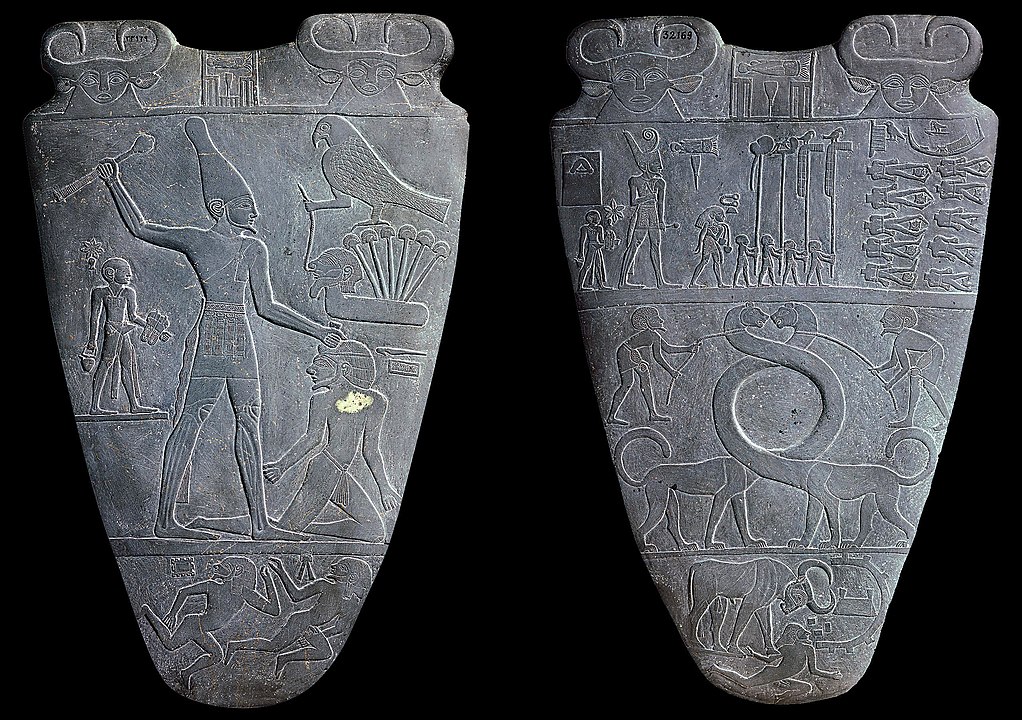
“The Narmer Palette” by unknown licensed under public domain.
The first pharaoh, or ruler, Narmer (aka Menes), is given credit for consolidating Upper and Lower Egypt c. 3100 BC from the previous independent competing kingdoms of Predynastic Egypt. The Narmer Palette depicts Narmer defeating his enemies. On one side (left), Narmer wears the white crown of Upper Egypt and postures over an enemy. On the other side (right), wearing the red crown of Lower Egypt he marches to view decapitated prisoners. The entwined creatures likely symbolize harmony. Narmer combined the white crown of Upper Egypt and the red crown of Lower Egypt, symbolizing a unified Egypt. Interestingly, elaborate headdresses worn by important leaders along with staffs symbolizing power are recurring themes in prehistory—think of the Maya, Moche, and Mississippian. Also, note that Narmer is grabbing the hair of his vanquished foe, not so different from the much later ritualized combat of the Moché. The veracity of Narmer as the first pharaoh, conquering by force remains debated in archaeological and historical circles. There is little evidence for a violent overthrow and the textural evidence is also scant. As with the Maya, rulers could have used images for political propaganda. Then again, as we have seen with the ancient Moche, virtually nothing is off the table, and events depicted in art could represent real-life events.
The Old Kingdom
The Old Kingdom (ca. 2575 to 2134 BC), which comprised the 4th to 8th dynasties, was in many ways a continuation of the Archaic Period and was characterized by prosperity and stability. The pharaoh had secular (non-religious) and sacred powers and was the earthly manifestation of Horus (falcon god) or the son of Ra (the sun god). Ra’s identity was often fused with others in an attempt to unite different areas. The pharaoh’s duty was to mediate with the gods and assure the annual flood cycle.
The Old Kingdom was centered in Memphis and was characterized by massive public works, like the construction of royal tombs and temples. The layout of early Memphis is unclear, but it appears the central area was dominated by the palace surrounded by a fortress of white walls. The necropolises (cemeteries for an ancient city) for Memphis were Saqqara and Giza. The Pharaoh Djoser had the Step Pyramid at Saqqara built northwest of Memphis, with a vast necropolis or mortuary complex. The stepped sides were oriented to the cardinal directions. The pyramid inaugurated the practice of pyramids as royal tombs. The king’s body was buried in a chamber beneath the pyramid. The Step Pyramid at Saqqara was designed by Imhotep and was surrounded by a stone wall. The king made public appearances here during life.

Saqqara pyramid of Djoser
The pyramids of Giza—the Great Pyramid (Pyramid of Khufu, c. 2560–2540 BC), the Pyramid of Khafre, and the Pyramid of Menkaure—were built during the Old Kingdom period. After death, the pharaoh was buried in a chamber in the pyramid and joined the sun god, the pyramids being symbolic ladders to heaven. More than 2 million limestone blocks went into the construction of the Great Pyramid (compare to Huaca del Sol in the Moché river valley).
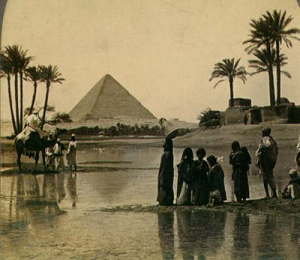
“Great Pyramid of Giza from a 19th-century stereopticon card photo” by unknown licensed under public
domain.
The Great Pyramid was part of a larger complex with an enclosure wall, a memorial or mortuary temple, causeways, queen pyramids, and pits. Causeways or sacred roads are another recurring themes. Remember the Great Hopewell Road, the Chacoan roadways, and the Maya sacbes? Excavation at the Great Pyramid complex revealed the remains of an Egyptian boat, the Khufu ship, made of cedar planks. This ship is sometimes called the solar barque and might have been the vessel to carry the King to the heavens with the sun god Ra. This ship is analogous to the vessel possibly portrayed on the Nebra Sky disk. It is also possible that the vessel was used by the king for actual voyages along the Nile. The Great Sphinx of Giza—a recumbent lion with a human head—appears to be associated with the funerary complex of the Great Pyramid. The combination of human and feline goes back to the Upper Paleolithic with the Lion Man of Hohlenstein Stadel, Germany dating to ca. 38,000 years ago. And we saw humans wearing leopard and jaguar skins at Catalhoyuk, Turkey, and among the Classic Maya at Bonampak.
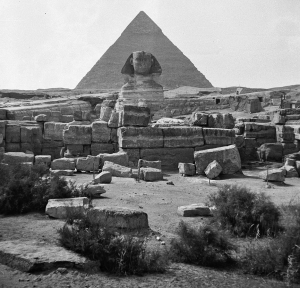
Sphinx & Great Pyramid at Giza, Egypt by Tom Beazley is licensed under CC BY 2.0
A complex system of taxation involving agricultural products, raw materials, and labor was in place in the Old Kingdom. The increasing number of mortuary and ritual centers during the Old Kingdom required support for their maintenance. Through time, these became more poorly built and smaller. The Old Kingdom became increasingly decentralized as nomarchs gained power and fought with each other, resulting in political instability. One text, the “Lamentations of Ipuwar,” relates “The land is full of gangs and a man goes to plow with his shield…All is in ruin, a man smites his brother, plague is throughout the land, blood is everywhere…The land is diminished, its rulers are multiplied.” The pharaoh granted estates to priestly specialists, which eventually diminished the pharaoh’s resources. Prolonged drought also weakened the state, and the Old Kingdom came to an end. This period of strife is known as the First Intermediate Period.
Middle Kingdom
The Middle Kingdom (11th to 14th dynasties) was centered in Thebes in Upper Egypt but moved back to Memphis in the 12th dynasty. Thebes became a religious center for the god Amun-Re. Pharaohs of the Middle Kingdom were less despotic than the Old Kingdom and the status of the pharaoh was diminished. A few smaller pyramids were built during this period, but the practice virtually died out by the end of the Middle Kingdom.
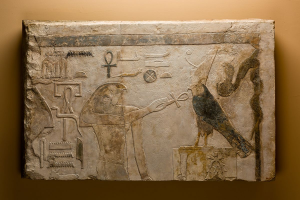
Above: Relief of Amenemhat I from his mortuary complex at El-Lisht licensed under CC BY SA.
Trade increased during the Middle Kingdom, particularly with Nubia (Sudan) to the south and Palestine to the northeast. The Hyksos “ruler of foreign countries” from western Asia took control of northern Egypt. Ambitious mining and construction projects weakened political control, leading to the Second Intermediate Period, a time of decline.
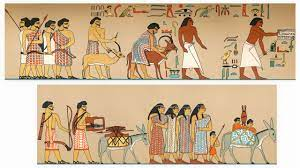
Above: Depiction of Asiatic people, possibly Hyksos, entering Egypt, c. 1900 BC licensed under CC BY SA.
The New Kingdom
The pharaoh Ahmose of Thebes drove the Hyksos out of northern Egypt, ushering in the New Kingdom (1530 to 1075 BC). The New Kingdom was a time of centralization of power and is one of the best-known periods. The 18th Dynasty of the New Kingdom is known as Egypt’s Golden Age. Kings were military, religious, and judicial leaders, and the New Kingdom extended rule farther north than ever before. Armies and priesthoods became increasingly powerful. The political capital returned to Memphis and Thebes became an important religious center. Many ambitious construction projects occurred during this time. Ramesses II (Ramesses the Great) built more temples, statues, and obelisks than any other pharaoh. An obelisk is a large column built from a single piece of stone with a pyramidal shape at the top. There is very little mention of slaves in Egyptian writing, but there are texts referring to conscripted labor called corvée labor. It is therefore thought that people were required to work for the state at least for part of the year, similar to military service in some countries today. Evading state work resulted in serious penalties.
Unlike the pyramid tombs of the Old Kingdom, the Valley of the Kings, on the west bank of the Nile opposite Thebes, was the burial place for pharaohs and nobility during the New Kingdom. Most of these tombs were carved into limestone rock, and most of these were robbed in antiquity. Care and expense were devoted to mummification in the New Kingdom. King Tutankhamun was pharaoh during the New Kingdom. His tomb was discovered in the Valley of the Kings by Howard Carter. Many obelisks—carved out of a single piece of granite—were constructed during the New Kingdom under the reign of Hatshepsut, a woman pharaoh. A woman as pharaoh went against the Egyptians’ idea of the correct order of the world or ma’at. Most Egyptian obelisks, eight of them, are now in Rome. The Washington Monument in Washington D.C. was inspired by Egyptian obelisks, though it is not built from a single piece of stone. The monument was a way to connect the relatively new country to the mystery and power of ancient Egypt.
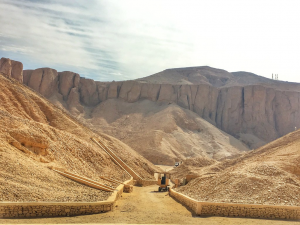
Valley of the Kings licensed under CC BY SA 2.0
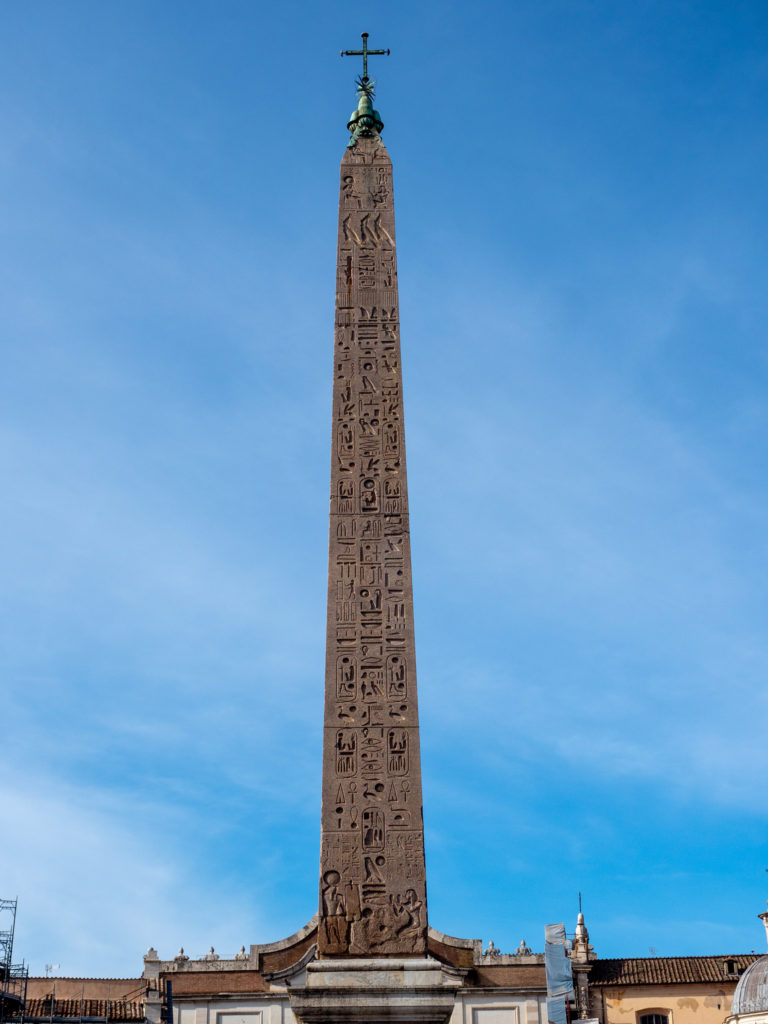
“The Flaminio Obelisk (An Egyptian obelisk of Ramesses II brought to Rome from Heliopolis) Piazza del Popolo.” by Charles Ng is licensed under CC BY 2.0.

“Small sphinx of Hatshepsut” by Keith Schengili-Roberts is licensed under CC BY 2.5
New Kingdom pharaohs promoted the god Amun-Re, whose cult was based at Karnak. Amenhotep IV promoted another god, Aten, and established a new capital at Amarna (also called Akhenaten), escaping the influence of the powerful priesthood. Akhenaten banned the worship of other gods and had their names expunged from monuments. The art of the period changes dramatically. Bodies become androgynous (sexually ambiguous) and heavily drooping, and heads are egg-shaped. This period is known as the Amarna Period. After his reign, Egyptians returned to the previous religion.
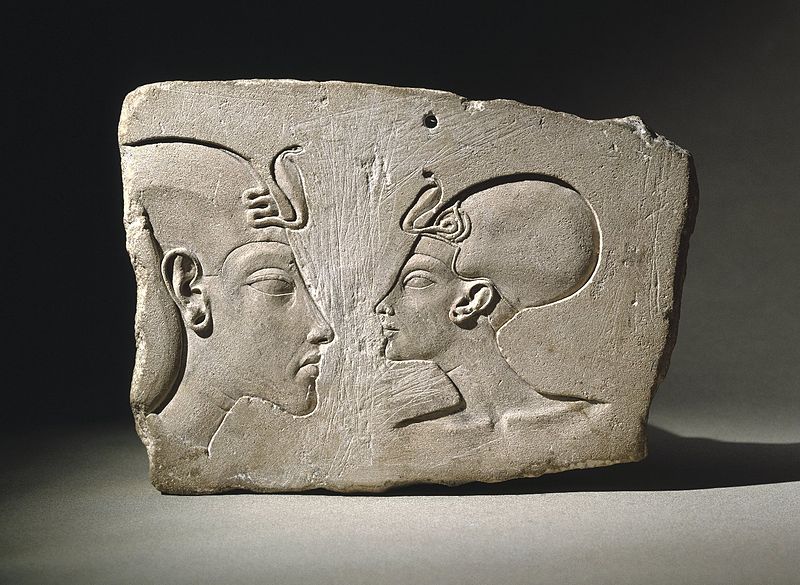
“The Wilbour Plaque, ca. 1352-1336 B.C.E” by Brooklyn Museum is licensed under public domain.
As Egyptian neighbors increased in power, pharaohs turned to diplomacy. The Amarna Letters from Tell El Amarna are a collection of 350 clay tablets that served as diplomatic letters between Egypt (Amenhotep III) and its neighbors, mainly concerning mutual defensive pacts and the exchange of gold, lapis lazuli, ebony, horses, ivory, and ebony. Gifts and wives were exchanged between Egypt and other kingdoms, ushering in an era of diplomacy rather than warfare. Pharaohs married daughters of western Asian kings, but Egyptian daughters never married foreign rulers (p. 43). Thutmose III brought the sons of conquered foreign towns to be educated in Egypt and indoctrinated in Egyptian ideology.
The Rammesides came to power in the 19 and 20th Dynasties as the Assyrians were coming to power in the Near East. The biblical account of Exodus is placed by some scholars during this period. Hebrew names are known from Egypt during the New Kingdom and Hebrews are known to have worked on state projects. No mass exodus, however, was recorded. Huge mortuary temples were built at Thebes, putting a strain on resources. Worked for the royal tomb and went on strike when the government was unable to pay. Rameses II had his memorial temple built at Thebes, now called the Rassesseum, where the colossus head “the Younger Memnon” was discovered, (and taken to the British Museum in 1818). The finds inspired Percy Bysshe Shelley’s sonnet Ozymandias. Nile inundations have taken their toll on the monument along with neglect. At Abu Simbel, Ramesses II had two massive temples carved into the rock face along the Nile built for him and his wife in Nubia (southern Egypt). The monuments were built between 1264 and 1244 B.C. The temples were cut into blocks and moved to higher ground in 1968 when threatened by the construction of the Aswan Dam. Today, these are listed on UNESCO’s World Heritage site list.
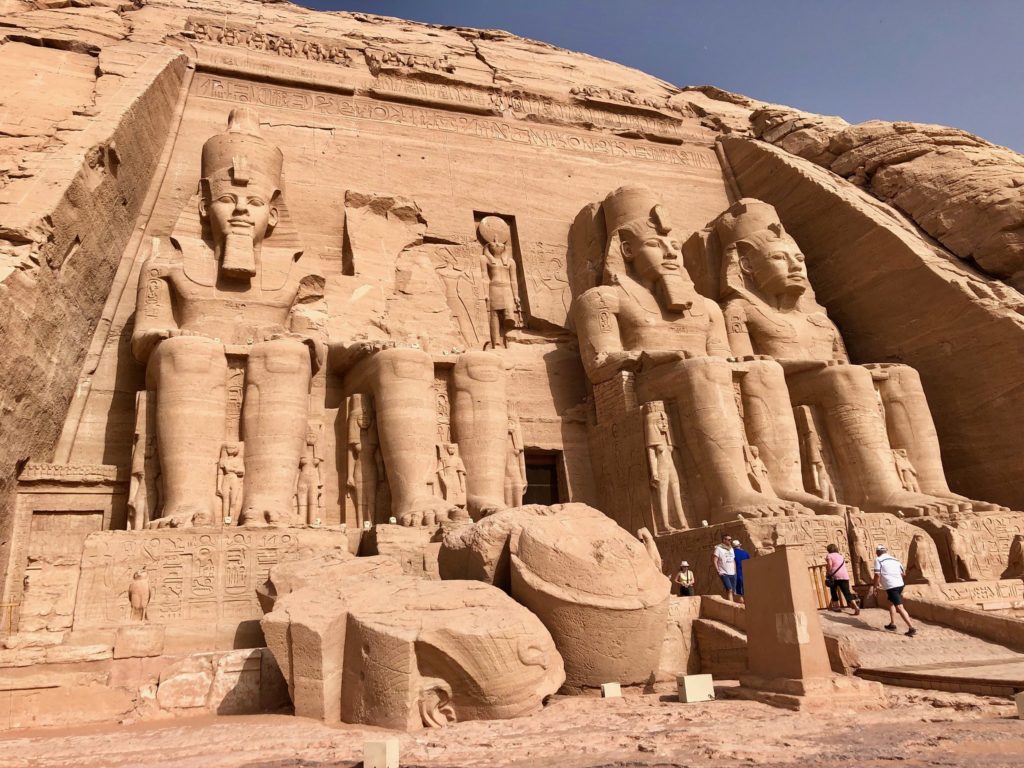
“The Great Temple of Ramses II, Abu Simbel, AG, EGY” by Warren LeMay is licensed under public domain.
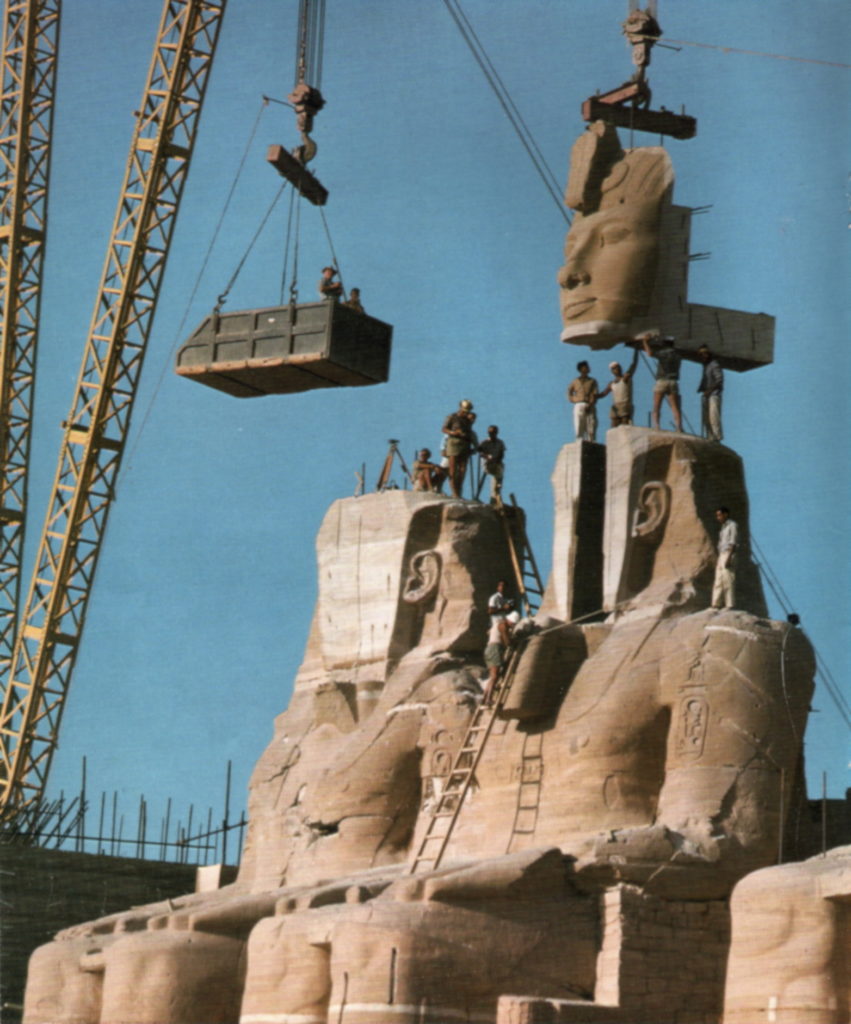
“The statue of Ramses the Great at the Great Temple of Abu Simbel is reassembled after having been moved in 1967 to save it from being flooded” by Per Olow licensed under public domain.
Growing unrest, corruption, and unsuccessful military campaigns led to the Third Intermediate Period a time of political decentralization. The Assyrians attacked Thebes carrying booty and obelisks back to Assyria. The Late Period saw an artistic renaissance that looked back on Egypt’s greatness. Nubian, Egyptian, and Persian kings ruled at different times in the Late Period. The occupation of Egypt by Alexander the Great removed the Persians and brought the Late Period to a close, after which Egypt was ruled by the Macedonian and Ptolemaic dynasties. Egypt became a Roman colony in 30 BC.
Belief
The Egyptian sense of order was called maat or ma’at, and transgressions against righteous behavior could result in chaos. Everyone from the lowliest peasant to the pharaoh was responsible for maintaining maat. In the Book of the Dead, Spell 25 indicates rightful behavior: “I have not slain people. I have not been sullen…I have not had intercourse with a married woman…I have not disputed the king.” The pharaoh was instrumental in ensuring the maintenance of harmony through offering to the gods in temples. The pharaoh was the incarnation of the god Horus (who avenged the death of his father Osiris). Egyptians revered and valued life, but prepared for death. Upon reaching adulthood, one began making arrangements for his or her tomb. The Egyptians believed that the soul separated into different parts upon death. The ka took the physical form of the person and required all the things that the living needed. Unlike other civilizations that we’ve studied, the Egyptians believed that the mere representation of things, like servers, acted as the real thing in the afterlife. Human sacrifices were therefore not performed after the first dynasty. The soul also took the form of ba with the head of the person and the body of a bird. The ba stayed with the sarcophagus at night in the tomb. During the day, the ba flew away to be in the sunshine. Finally, the akh was the spirit of the dead that mingled with the gods. Mummification was necessary for the ka and ba. The sarcophagus was often in the shape of the deceased so the ba could recognize the correct person, and sometimes facial features were modeled using plaster. The process of mummification changed over time, with the earliest being naturally desiccated corpses in pits. With the use of sarcophagi, other means were necessary to preserve the body, including removal of the internal organs (the heart was often left in the body), packing the body with natron (a natural salt), and wrapping the body in linens. Canopic jars were used to house the organs. The soul of the deceased was judged in the afterlife. The dead would recite the liturgy from the “Book of the Dead”: I gave bread to the hungry, beer to the thirsty, clothes to the naked, and a boat to him who was boatless.”
Writing and Scribes
Like the Maya, Egyptians had a true writing system in addition to scribes. Also, like the Maya, not everyone was literate and it is estimated that only one percent of the Egyptian population could read and write (p. 77). Unlike the Maya, the Egyptians had vast archives to keep track of herd sizes, grain, production of goods, wages, booty, fallen enemies, as well as letters, wills, titles, inventories, journals, regulations, conscription lists, and so on. Close accounting made taxation and conscription possible. Scribes wrote on ceramic or limestone scraps, while formal documents were written on papyrus made from overlapping reeds. Scribal instructors were strict. On one papyrus text, it warns, “Scribe do not be idle…Do not give your heart to pleasures, or you shall be a failure…Preserve in action every day, so that you may gain mastery. Spend no day in idleness or you shall be beaten—a boy has a back, and he listens to a beating.”
The Rosetta Stone was discovered in 1799 by Napoleon’s invading forces. The granitic tablet contains texts in ancient Greek, and Egyptian hieroglyphs and demotic, a cursive form of the hieroglyphic script. The multiple scripts allowed epigraphers to decipher the hieroglyphs, once thought to be completely pictographic. Thomas Young proposed that the cartouches, ovals enclosing groups of hieroglyphs, on the Rosetta Stone contained royal or religious names, leading to a breakthrough in decipherment. Jean François Champollion announced the complete decipherment of Egyptian hieroglyphs in 1823. Egyptian hieroglyphs are logophonetic, meaning they use logograms and symbols that stand for one or more sounds. Hieroglyphs also contained determinatives, which are added at the end of a word to indicate the category to which the word belonged.